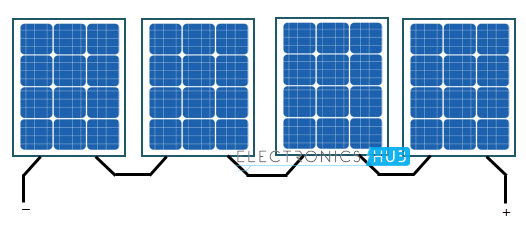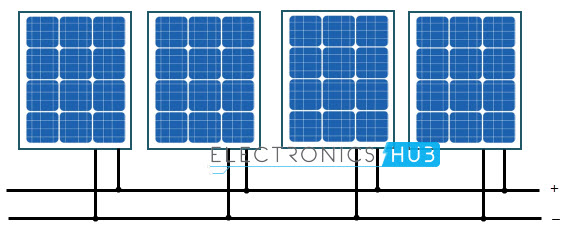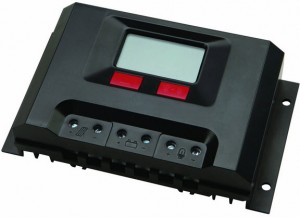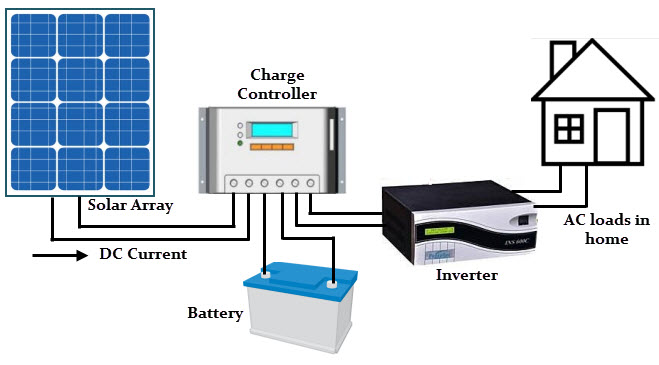As a major source of electrical power generation fossil fuels are depleting day by day and also its usage raises serious environmental concerns. These reasons force the development of new energy sources which are renewable and ecologically safe. The renewable energy sources include wind, solar, water, biomass and geothermal energy sources. Out of which, solar energy has the greatest potential in the long term and is predicted to play a major role in coming years. It is the cheapest method of generating electricity compared with other energy sources.
What is Solar Power and Why to Choose?
Solar power is the conversion of sun radiation into electricity through the use of solar photovoltaic cells. This conversion takes place in the solar cell by photovoltaic effect. As said by many experts that the amount of solar energy reaching the earth is more than 10000 times the current energy consumption by man. Also, the power created by solar is sufficient for one year for the entire planet, if we could convert the 100 percent of the solar energy into electricity in one hour. There are several applications that use solar power, here is the information on the generation of electricity through PV cells. The solar power generation is the most efficient route for power generation because it takes a minimum number of steps (for producing electricity) than that of other generation methods.
There are two ways of converting sunlight into electricity. In one method, solar energy is used simply as a source of heat. This heat is further used to produce the steam, which drives the steam turbine. This method of power generation is called solar thermal power generation. In the second method, solar energy is directly converted into electricity using PV (or solar) cells as mentioned above. The PV cell is made with silicon semiconductor material. Some of the factors for choosing the solar power generation are listed below.
Solar energy is available freely and conveniently in nature and it needs no mains supply. Solar generation plant can be installed in a few months while the conventional power plants take several years to build an electricity generation plant. Solar power is clean energy as it produces no air or water pollution. Also, there are no moving parts to create noise pollution. Unlike fossil fuels, no toxic emissions are released into the atmosphere during solar energy power generation. Solar power has less running cost that means once the capital investment is made, there is no need for continues purchase of fossil fuels as the solar energy is effectively free in nature.
How Solar Power Generated from PV Cell?
A PV cell (can be called as a solar cell) is a semiconductor device that converts the sunlight energy into electricity without going through any energy conversion steps. This conversion takes place by photovoltaic effect and hence they are called Photovoltaic (PV) cells. It generates voltage and current at its terminals when sunlight incident on it. The way and the amount of power generated by a solar cell depend on the sunlight falling on it. This also includes some factors such as intensity of light, angle at which the light falls on it and area of the cell. The more is the power generated, if higher is the light intensity. If the area of the cell is more, the power generated is also more. And the optimum power is generated by it when light falling is perpendicular to the front side of the cell. The solar cells are made with silicon semiconductor material and is treated with phosphorous and boron to make a thin silicon wafer. The wafer layers are then aligned together to make the solar cells, once they are doped. Irrespective of the technology and material used, every solar cell has two terminals (positive and negative terminals) so as to take the electric current from it. Typically, a solar cell consists of front contact at the top, PN junction in the middle and back contact at the bottom. Basically, the sunlight consists of bundles of photons, where each photon has a finite amount of energy. To generate the electricity from a solar cell, these photons must be absorbed by it. The energy of the photon and also the band-gap energy of semiconductor material decide the absorption of a photon. Here is the term Electron-volt (eV) which is the unit of energy that expresses the photon energy and the band-gap energy of a semiconductor material. The semiconductor material of the solar panel absorbs the photons in the sunlight. Due to this, electron-hole pairs are generated at the junction. When the solar cell is connected to the load, electrons and holes at the junction are separated from each other where the electrons are collected at the negative terminal and holes at positive terminal. Thus the electric potential is built between the terminals and hence the voltage is developed across it. This further drives the current (DC) to the DC loads, inverter, or battery charging circuit. If more photons are absorbed, greater will be the current generated. However, much of the solar radiation fall on the solar cell is not converted into electricity. This is because light is composed of photons of different wavelengths. Some photons hit the solar cell and then reflected and prevented from entering to the cell. In some materials, generated electrons recombine with other molecules before being drawn into current. Likewise, there are many reasons for the low conversion rate or efficiency. The conversion efficiency of the solar panels used in individual residences ranges from 6 to 10%. And for large-scale installations and solar power plants, solar panels are designed with best material and technologies to achieve higher conversion efficiency ranging from 40 to 60%, but they are costliest.
http://www.wifinotes.com/energy1/images/array-of-pv-solar-cells.gif A single solar cell of 4 cm2 develops a voltage of 0.5 to 1 V and it can produce 0.7W power when exposed to the sunlight. Typically, the best designed solar panel has a maximum efficiency of 25%. In order to generate high potential difference or voltage and more electric power, these individual cells are connected together that means some cells are connected in series and some are in parallel. PV modules are formed by connecting the number of number of solar cells together. And several PV modules are connected together to make a PV array which can be used for small power as well as high power generation applications.
Components of Solar Energy Electricity Generation
The major components in solar energy electricity generation include
Solar Panels
Solar cell modules or solar panels convert the solar energy into electricity. These are mounted in such a way that they collect maximum energy from the sun. Most solar panels are rated to a voltage 12V (a half volt PV cells are connected in series, inside of the solar panel to produce the high voltage say 12V). The panels are connected in series to form a solar array that produces higher voltage, typically of 24 or 48V in standalone systems, or it can be several hundreds of volts in grid-connected systems. If the panels are connected in parallel, the current delivered to the load will be more and hence the more power while maintaining the same voltage. Irrespective of series or parallel connection, the power rating of the system increases when multiple solar panels are connected together. Here, a solar array is made with four 12V and 12 watt solar panels, where each panel produces a current of 1 A. Then this array would be rated as 48V, 48W with 1A current.
If the same rated solar panels are connected in parallel to form an array of four solar panels, then the solar array would be rated as 12V, 48W with 4 A current.
Batteries
Except the grid-connected system, all other solar energy power generation systems use batteries to store the energy generated from solar panels. Since the amount of solar power generated depends on the strength of the sunlight, batteries provide a constant source of power supply once it is fully charged. Mostly, lead acid batteries are used in solar electric systems. Like solar panels, batteries can be connected together to form a battery bank. These can be connected either series or parallel as similar to solar panels to achieve desired voltage, current and power ratings. The type of battery chosen depends on the energy requirements of a system and its budget.
Controller
It regulates the flow of current into and out of the battery. If the generated current overcharges the battery, it leads to damage in the battery. Moreover, if the battery is completely discharged, it will destroy the battery. Hence the solar controller prevents the batteries to undergo these conditions. The charge controller module balances the amount of electricity used to power appliance and lights with generated power. Also, it prevents the damage to the batteries due to overcharging and deep discharging. In addition, it gives the alarm when the module not functioning properly.
Inverter
The electricity generated from the solar panels is a Direct Current (DC), whereas the most electrical appliances work on Alternating Current (AC) and hence a converter is needed to convert DC to AC, nothing but an inverter. Also, if the solar system is connected to the grid, the generated DC voltage must be converted into AC. So the inverter equipment converts the DC voltage to the AC and to the same voltage as that of grid or appliance rating. As a recent invention, most individual solar panels are connected with micro inverters that provide a high AC voltage. These are suitable only for grid-connected systems and not suitable with battery backup systems.
Different Types of Solar Electric Systems
There are different configurations of solar electric system and are discussed below.
Off-grid/Standalone Solar Electric Systems
These are the most popular type of solar installations which are primarily designed to supplement or replace the conventional mains supply. These are mainly used in the locations where there is no other source to provide power supply and hence these are used in remote locations and rural areas where it is difficult to get the power from grid extensions.
Generally, off-grid systems use solar power to charge the batteries, and this charge is then supplied to the load when needed. The battery power either directly operates the DC loads (DC lamps) or drives the power inverter that converts the DC power to AC power to operate the appliance like pumps, lighting equipment, refrigerators, etc. This method is followed for any standalone system whether it is a pocket calculator or a complete off-grid home. Standalone systems are comparatively small and simple systems.
Grid-connected Solar Electric Systems
These systems effectively create a micro power station and are connected directly into the electricity grid. These are normally found in urban areas where power is readily available. During the day it feeds the excess electricity generated into the grid and during evening and night it imports the electricity from the grid. Here the grid acts like a storage medium in which power is taken from the grid when needed. It is to be noted that, grid-connected system doesn’t have to supply enough electricity to cover entire power demand. So this system can be small or large depends on the owner’s choice. This system receives the payment for each kilowatt of power which is supplied to the electricity providers. This type of installation reduces the dependence on electric utilities and hence reduces the electricity bills. The major components in this solar installation include a PV array or solar cells, inverter and the metering system. The main disadvantage of the grid-tied solar system is that it will switch off in the event of power cut, because this system is the part of utility grid and hence if there is a power cut, the power from the solar array is also switch off. If this system won’t stop, current flow back into the grid could lead to serious faults.
Central Grid-connected Solar Electric Systems
In a conventional grid system a variety of power sources such as gas, coal, water, etc. combined and it supplies the power to end user via transmission and distribution lines. Likewise, a central grid connected system is directly connected to the transmission lines. These systems can be small (as 50kWp), large (as 100kWp) or somewhat higher range say 1GWp which all are directly connected to the transmission systems. Mostly, these are called as solar power plants.
Grid Fallback Solar Electric Systems
It combines the grid connected system with a bank of batteries. In this solar array generates the electricity, which in turn charges a battery bank. The battery power is then running the inverter which drives the loads through an inverter. When the power in the batteries is not enough to drive the loads, the system automatically switches back to the grid power supply. Again, it switches back to battery power once the solar array recharges the batteries. This system doesn’t sell any power to any electrical utilities and the overall power generated used for domestic or residential systems alone. In this article, you came to know about the working theories of solar panels and the components used for generating the power. You may not know about the solar panels available in the bazaar at affordable prices. For those who want to reduce the electricity bill and to generate the high power signals, we have come with the Top 14 Best Solar Panel Kits for Homes in 2018 that helps you to make the right choice. Comment * Name * Email * Website
Δ

















![]()